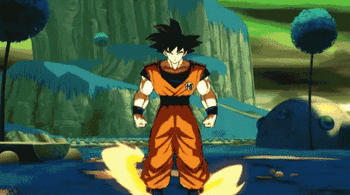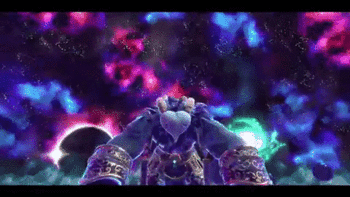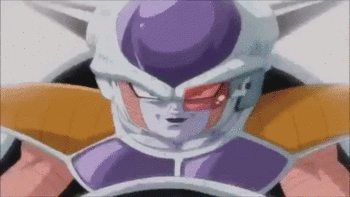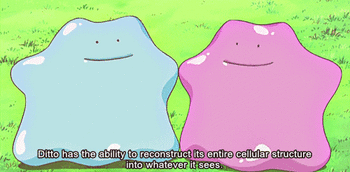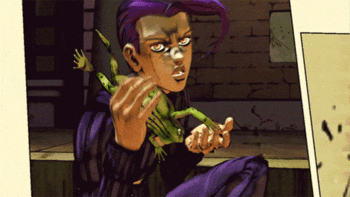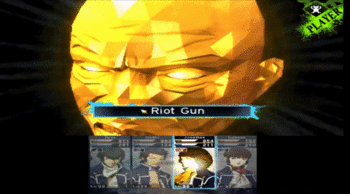The official discord link if you wish to join the discord: https://discord.gg/j5RKwCvAFu
Support the wiki on our official Ko-Fi page or Patreon page!
Transformation: Difference between revisions
| Line 7: | Line 7: | ||
==Types== | ==Types== | ||
===Type 1: Partial Transformation=== | |||
* ''' | [[File:Type_1_Transformation.gif|middle|350px]] | ||
* ''' | |||
* ''' | This is the most basic of transformations, and in some cases, it doesn’t do much in its own right. A real world example would be animals like Chameleons. They are well known for their ability to camouflage by changing the color of their skin to match their surroundings. This would be an example of Type 1, as whilst it changes a feature of their bodies, it doesn’t create any vast differences. Looking to fiction, [[Son Goku]] from popular franchise [[Dragon Ball]] may come to mind, with his ability to change his eye and hair colors to more exotic choices, as well as gain a new hairstyle. These are undoubtedly transformations, however they don’t change his anatomy in any real particular way. | ||
* ''' | |||
* ''' | However, changing color is not the only way in which one can qualify for Type 1 Transformation. A primary example of this being [[Mario]], the protagonist of [[Nintendo]]’s flagship series. When using a Super Mushroom, Mario is able to grow twice his original height, and when using a Mini Mushroom, he can shrink down to fit into small areas. These, too, would be considered transformations, however Mario doesn’t exactly change in ways that would be considered radically different. His basic anatomy remains the same, it’s just he’s changed in size. Whilst you may wish to argue this is Size Manipulation, this doesn’t seem the case as it also changes the structure of his body as opposed to commanding his size/growing. | ||
* | |||
* | Generally, changes to the body that only alter what you have in your base anatomy are what Type 1 is in a nutshell. | ||
*'''Users:''' [[Son Goku]] [[Dragon Ball|(Dragon Ball)]], [[Mario]] [[Super Mario Bros.|(Super Mario Bros.)]], [[Sonic the Hedgehog]] [[Sonic the Hedgehog (Franchise)|(Sonic the Hedgehog)]] | |||
===Type 2: Morphing=== | |||
[[File:Type_2_Transformation_Void.gif|middle|350px]] | |||
Type 2 is essentially transforming of the existing anatomy: you can only work with what you have. For example, a popular JRPG enemy, the Slime are little blobs of a fluid substance. As such, how they shape their body is their desire. How they operate is essentially [[Body Control]], such as limiting themselves to puddles, or creating an arm from their being to carry out a task. However, they are limited to their body. Whilst they can take on a number of shapes, they are limited to the slime body. | |||
Another example, Void Termina from Kirby Star Allies can turn his hands into swords or his arms into wings, however he is seemingly limited to just these few alterations to his body. Kirby [https://vignette.wikia.nocookie.net/debatesjungle/images/6/6c/Type_2_Transformation_Kirby.gif/revision/latest?cb=20190131165040 is able to transform his face into a boomerang and throw it]. Since he isn’t really changing in any radical ways, just reshaping his existing anatomy, this counts as Type 2. | |||
In essence, a being with Type 2 can turn certain parts of their body into other things, but cannot transform their body as a whole into something radically different. | |||
*'''Users:''' [[Asura (Asura's Wrath)]], [[Kirby]] [[Kirby (Franchise)|(Kirby)]], [[Cuphead]] [[Cuphead (Verse)|(Cuphead)]] | |||
===Type 3: Transformative Arsenal=== | |||
[[File:Type_3_Transformation.gif|middle|350px]] | |||
Transforming your body into something radically different is what falls under Type 3. Generally, this is for the more obvious transformations, however they are limited in how exactly they come about. An example from folklore being werewolves, humans who look upon a full moon and change into a wolf-like beast. This is a way to imagine Type 3 Transformations. A werewolf may be capable of changing in a way that makes them unrecognizable from their other form, but they cannot become exactly what they please. Another example would be vampires, who can take on the form of a bat. To look to fiction, in Dragon Ball [[Frieza]] looks vastly different at the start of the arc to the end of the arc he debuted in due to his numerous transformations. They alter his body in a way so that he is a very different looking being with each form, however, the forms he can achieve had already been set in stone, he couldn’t become anything he wished. | |||
*'''Users:''' [[Frieza]] [[Dragon Ball|(Dragon Ball)]], [[Japhet]] [[OFF|(OFF)]], [[Samus Aran]] [[Metroid (Series)|(Metroid)]], [[El Tigre]] (El Tigre: The Adventures of Manny Rivera) | |||
===Type 4: Shapeshifting=== | |||
[[File:Type_4_Transformation.gif|middle|350px]] | |||
Type 4 is essentially an enhanced version of Type 3. A good way to visualize this would be [https://www.youtube.com/watch?v=cnvNNpyXW2c the showdown between Merlin and his nemesis Madam Mim] in the Disney film Sword in the Stone, in which they use magic to take on a multitude of different animal forms to combat one another. The user can become whatever they so desire on a whim, such as becoming an object that may come in handy for a task, another creature, a cloud of particles or something entirely different. | |||
*'''Users:''' [[Impostor (Among Us)]], [[Conker the Squirrel]] [[Conker (Series)|(Conker)]], [[Queen Zeal]] [[Chrono (Series)|(Chrono Trigger)]] | |||
===Type 5: Permanent Transformation=== | |||
[[File:Type_5_Transformation.gif|middle|350px]] | |||
Unlike those before it, Type 5 is not an ascension of its predecessor. Instead, it focuses on the case of transformations that are made to last. Usually they are similar to Type 3 in how the form which is taken on is quite different from the form before it, however now it is permanent. A way to imagine this would be Pokémon Evolutions (like Eevee’s, seen above), which involves the Pokémon in question entering a new state and staying like this, essentially evolving into its new form. Numerous characters can achieve this through different means, however the end result is the same: they’ve taken on a new body. | |||
Sometimes there are scenarios in which the transformation can be reversed, for example when Perfect Cell releases #18 from his body in Dragon Ball, he is forced to revert to his Semi-Perfect state. However, since he otherwise would have stayed in his Perfect form, his transformation still qualifies for being a permanent transformation, it just holds a weakness that can reverse the transformation it if exploited. This is not the case for all Type 5 transforms, however, as some have no known way of returning to their original state. | |||
*'''Users:''' [[Cell]] [[Dragon Ball|(Dragon Ball)]], Pokemon from [[Pokémon]], [[Ava Ire]] (Ava's Demon) | |||
===Type 6: Hide and Seek=== | |||
[[File:Multiple_Personalities.gif|middle|350px]] | |||
The name “Hide and Seek” is in reference to the famous Dr Jekyll and Mr Hyde, who were named such to parallel the name of said game. However, the idea of two individuals in one body is not unheard of in other works of fiction, and even in the real world it appears to be the case, except not as extreme. Type 6 is a case usually similar to Type 1 in that a few features of the appearance are changed, however the cause is due to the fact that multiple individuals share a body, and the dominant soul has their own distinct appearance. For example, The Boss from JoJo’s Bizarre Adventure Part 5, who is eventually revealed to be named Diavolo, is able to hide his identity effectively by taking advantage of his alter ego, Vinegar Doppio, who looks radically different from him. | |||
*'''Users:''' [[Diavolo]] [[JoJo's Bizarre Adventure|(JoJo's Bizarre Adventure)]] | |||
===Type 7: Dimension Shifting=== | |||
<gallery position="center" captionalign="center" widths="400" orientation="none" bordersize="none" bordercolor="transparent" captiontextcolor="#e7d835" captionsize="small" captionposition="below" columns="3" spacing="small" navigation="true"> | |||
Type 7 Transformation.gif | |||
Type 7 Transformation Link.gif | |||
Type 7 Transformation Mario.gif | |||
</gallery> | |||
The user can ascend to a higher dimension, such as Mario exiting his 2D 8-Bit form and taking on a three-dimensional form in Super Mario Odyssey, or descend to lower dimensions, such as Link’s ability to become a two-dimensional wall painting in Link Between Worlds. Being able to change how many dimensions you have classes you as a user of Type 7 Transformation. | |||
*'''Users:''' [[Mario]] [[Super Mario Bros.|(Super Mario Bros.)]], [[Link (New Hero of Hyrule)|Link]] [[The Legend of Zelda|(The Legend of Zelda)]] | |||
===Type 8: Concept Shifting=== | |||
[[File:IMG_2691.gif|middle|350px]] | |||
This is the ability to go from one concept to another. As an example, [[YHVH]] from [[Megami Tensei]], is the very concept and idea of the Abrahamic God, but through the [[Observation (Megami Tensei)|observation]] of the main cast, his concept was transformed into that of being a demon. He transferred from being the concept of the Abrahamic God to the concept of a demon, so this would be an example of Type 8. | |||
==Possible Uses== | ==Possible Uses== | ||
| Line 31: | Line 84: | ||
* Certain objects, artifacts or items may be required to unleash this transformation, leaving the user unable to do so without them. | * Certain objects, artifacts or items may be required to unleash this transformation, leaving the user unable to do so without them. | ||
== | ==Note== | ||
The initial idea of types and in-depth analysis came from [[User_blog:LuckyEmile/Transformation_Types_Explained|this blog]]. | |||
[[Category:Powers and Abilities]] | [[Category:Powers and Abilities]] | ||
{{Discussions}} | {{Discussions}} | ||
Revision as of 18:01, 13 October 2022

Background
Transformation is the power to alter your appearance in one way or another. The potency of the ability varies greatly, be it small changes such as modifications to certain aspects such as height, body parts, etc, or grand changes seen in Pokémon Evolutions or changing the very structure and make-up of one’s own form at will. Whilst many transformations are something the user can tap in and out of, certain users will find their transformations are permanent, putting weight on their decision. The transformation may come through willpower alone, certain emotions or an external source, among other methods. Transformations are also sometimes paired with amplification of statistics.
Not to be confused with Transmutation, which is transforming those/things other than yourself, or Fusionism, the act of two or more individuals merging to create a new form.
Types
Type 1: Partial Transformation
This is the most basic of transformations, and in some cases, it doesn’t do much in its own right. A real world example would be animals like Chameleons. They are well known for their ability to camouflage by changing the color of their skin to match their surroundings. This would be an example of Type 1, as whilst it changes a feature of their bodies, it doesn’t create any vast differences. Looking to fiction, Son Goku from popular franchise Dragon Ball may come to mind, with his ability to change his eye and hair colors to more exotic choices, as well as gain a new hairstyle. These are undoubtedly transformations, however they don’t change his anatomy in any real particular way.
However, changing color is not the only way in which one can qualify for Type 1 Transformation. A primary example of this being Mario, the protagonist of Nintendo’s flagship series. When using a Super Mushroom, Mario is able to grow twice his original height, and when using a Mini Mushroom, he can shrink down to fit into small areas. These, too, would be considered transformations, however Mario doesn’t exactly change in ways that would be considered radically different. His basic anatomy remains the same, it’s just he’s changed in size. Whilst you may wish to argue this is Size Manipulation, this doesn’t seem the case as it also changes the structure of his body as opposed to commanding his size/growing.
Generally, changes to the body that only alter what you have in your base anatomy are what Type 1 is in a nutshell.
Type 2: Morphing
Type 2 is essentially transforming of the existing anatomy: you can only work with what you have. For example, a popular JRPG enemy, the Slime are little blobs of a fluid substance. As such, how they shape their body is their desire. How they operate is essentially Body Control, such as limiting themselves to puddles, or creating an arm from their being to carry out a task. However, they are limited to their body. Whilst they can take on a number of shapes, they are limited to the slime body.
Another example, Void Termina from Kirby Star Allies can turn his hands into swords or his arms into wings, however he is seemingly limited to just these few alterations to his body. Kirby is able to transform his face into a boomerang and throw it. Since he isn’t really changing in any radical ways, just reshaping his existing anatomy, this counts as Type 2.
In essence, a being with Type 2 can turn certain parts of their body into other things, but cannot transform their body as a whole into something radically different.
- Users: Asura (Asura's Wrath), Kirby (Kirby), Cuphead (Cuphead)
Type 3: Transformative Arsenal
Transforming your body into something radically different is what falls under Type 3. Generally, this is for the more obvious transformations, however they are limited in how exactly they come about. An example from folklore being werewolves, humans who look upon a full moon and change into a wolf-like beast. This is a way to imagine Type 3 Transformations. A werewolf may be capable of changing in a way that makes them unrecognizable from their other form, but they cannot become exactly what they please. Another example would be vampires, who can take on the form of a bat. To look to fiction, in Dragon Ball Frieza looks vastly different at the start of the arc to the end of the arc he debuted in due to his numerous transformations. They alter his body in a way so that he is a very different looking being with each form, however, the forms he can achieve had already been set in stone, he couldn’t become anything he wished.
- Users: Frieza (Dragon Ball), Japhet (OFF), Samus Aran (Metroid), El Tigre (El Tigre: The Adventures of Manny Rivera)
Type 4: Shapeshifting
Type 4 is essentially an enhanced version of Type 3. A good way to visualize this would be the showdown between Merlin and his nemesis Madam Mim in the Disney film Sword in the Stone, in which they use magic to take on a multitude of different animal forms to combat one another. The user can become whatever they so desire on a whim, such as becoming an object that may come in handy for a task, another creature, a cloud of particles or something entirely different.
Type 5: Permanent Transformation
Unlike those before it, Type 5 is not an ascension of its predecessor. Instead, it focuses on the case of transformations that are made to last. Usually they are similar to Type 3 in how the form which is taken on is quite different from the form before it, however now it is permanent. A way to imagine this would be Pokémon Evolutions (like Eevee’s, seen above), which involves the Pokémon in question entering a new state and staying like this, essentially evolving into its new form. Numerous characters can achieve this through different means, however the end result is the same: they’ve taken on a new body.
Sometimes there are scenarios in which the transformation can be reversed, for example when Perfect Cell releases #18 from his body in Dragon Ball, he is forced to revert to his Semi-Perfect state. However, since he otherwise would have stayed in his Perfect form, his transformation still qualifies for being a permanent transformation, it just holds a weakness that can reverse the transformation it if exploited. This is not the case for all Type 5 transforms, however, as some have no known way of returning to their original state.
- Users: Cell (Dragon Ball), Pokemon from Pokémon, Ava Ire (Ava's Demon)
Type 6: Hide and Seek
The name “Hide and Seek” is in reference to the famous Dr Jekyll and Mr Hyde, who were named such to parallel the name of said game. However, the idea of two individuals in one body is not unheard of in other works of fiction, and even in the real world it appears to be the case, except not as extreme. Type 6 is a case usually similar to Type 1 in that a few features of the appearance are changed, however the cause is due to the fact that multiple individuals share a body, and the dominant soul has their own distinct appearance. For example, The Boss from JoJo’s Bizarre Adventure Part 5, who is eventually revealed to be named Diavolo, is able to hide his identity effectively by taking advantage of his alter ego, Vinegar Doppio, who looks radically different from him.
Type 7: Dimension Shifting
The user can ascend to a higher dimension, such as Mario exiting his 2D 8-Bit form and taking on a three-dimensional form in Super Mario Odyssey, or descend to lower dimensions, such as Link’s ability to become a two-dimensional wall painting in Link Between Worlds. Being able to change how many dimensions you have classes you as a user of Type 7 Transformation.
Type 8: Concept Shifting
This is the ability to go from one concept to another. As an example, YHVH from Megami Tensei, is the very concept and idea of the Abrahamic God, but through the observation of the main cast, his concept was transformed into that of being a demon. He transferred from being the concept of the Abrahamic God to the concept of a demon, so this would be an example of Type 8.
Possible Uses
- Certain users might be able to use this for impersonating others.
- The power could be used for healing, by swapping from a wounded state to an unwounded form, like seen here.
- The new form could grant new powers and abilities.
- The new form could be an augmentation, amping the likes of speed, power, durability, etc.
Limitations
- Certain transformations may come with a time limit.
- Certain transformations could make the user become unruly and unable to control themselves.
- Certain transformations may be unwanted by the user, such as those achieved through mutation or a curse.
- Whilst Type 5 is, by definition, permanent, certain scenarios could cause them to revert to an earlier state.
- Transforming into certain things may carry forth their weaknesses, fears, limitations, etc onto the user.
- Certain objects, artifacts or items may be required to unleash this transformation, leaving the user unable to do so without them.
Note
The initial idea of types and in-depth analysis came from this blog.
Discussions (Link For Mobile Users):
| Discussion threads involving Transformation |
